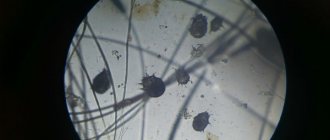Toxoplasmosis
in cats it is an anthropozoonotic disease (common to humans and animals) with very nonspecific symptoms.
The causative agent is Toxoplasma gondii
, a single-celled organism that parasitizes all organs and tissues of susceptible animals.
Infection with toxoplasmosis
possible in all species of warm-blooded animals and birds and distributed on all continents. But only in the intestines of representatives of the cat family does the pathogen undergo sexual development, and the infection spreads into the environment with feces (in the form of oocysts). In animals of other species, it develops without a sexual phase of development, while the parasite is not released into the environment, but spreads throughout the internal organs and tissues of the animal, leading to a chronic disease. The meat of a sick animal is one of the factors of infection for the animal that eats it.
Who causes toxoplasmosis?
The causative agent of toxoplasmosis is the smallest parasite Toxoplasma gondii , which is able to live in the bodies of many birds and mammals, penetrating into the cells of the body.
A feature of Toxoplasma is the ability to reproduce in two different ways:
- sexual (occurs only in the intestines of cats with subsequent release of oocysts in feces);
- division (occurs in the cells of other infected organisms).
In view of this feature, it is believed that the main route of entry into the human body is contact with a sick animal (caring for it, cleaning the toilet, etc.) without observing the basic rules of protection and personal hygiene.
However, there are many more ways for Toxoplasma gondii to enter the cat's body (and the human body). You can become infected:
- eating raw (or undercooked) contaminated meat such as pork, beef or venison;
- through contact with a sick animal or contaminated raw meat;
- during blood transfusions and organ transplants.
Toxoplasma is also able to penetrate the placental barrier, which explains another route of transmission - from mother to fetus during pregnancy.
Methods of infection
A cat can become infected with toxoplasmosis:
- Eating raw food, especially meat products.
- Drinking dirty water.
- During a scrape with other cats.
- Through a person's dirty shoes.
- During the period of eating infected grass.
Routes of infection
Domestic cats become infected with Toxoplasma by eating raw meat, caught birds and rodents. Small animals hunted by felines are carriers of parasites.
Toxoplasma reproduces only in the bodies of human pets and certain wild species of cats. Once in the intestines of rodents, birds or farm animals, Toxoplasma quickly invades macrophage cells and spreads to various organs. There they form intracellular latent forms (bradyzoites) and do not reproduce, since the host’s immune system quickly copes with the tachyzoids emerging from the cells.
By eating food or prey containing Toxoplasma in the latent phase of development, or licking fur contaminated with its own feces, a cat can become infected and re-infected with both intracellular and extracellular forms, as well as oocysts of the parasites. The duration of the incubation period depends on the type of pathogens entering the body: from 3-10 days to 2-3 weeks. Excreted in feces from the cat's intestines, protozoan eggs return to the natural environment (soil, water).
Based on the methods of infection, its sources can be determined. For cats they are:
- raw meat;
- small animals are objects of hunting;
- dirty tray;
- water from open sources (puddles, ditches, etc.).
What causes the disease
Toxoplasmosis is a dangerous parasitic endemic disease widespread throughout the world.
It can affect humans, many wild and domestic species of mammals, and birds. Cats, including natural species, are an important link in the epidemiology of this disease, as they play the role of definitive hosts of cysts.
The pathology is caused by the protozoa Toxoplasma gondii, first discovered in the North African rodent of the same name.
For the first time, infection of a cat was described in specialized literature only in 1942, and the life cycle of Toxoplasma - in 1970.
A thorough knowledge of this cycle is necessary in order to have an idea of the possible routes and timing of human infection from pets.
Also read about toxpolasmosis in humans.
Feline pregnancy and toxoplasmosis
If Toxoplasma gundi infects a pregnant female, then the risk of intrauterine infection of the fetus is very high.
The consequences are miscarriages, the birth of dead or non-viable kittens.
But it should be remembered that infection through the placenta is possible only in the first, shortest, stage of oocyst development. That is, a danger to the offspring can only arise if the female is infected either right before pregnancy or in its first days.
With chronic toxoplasmosis, a cat cannot infect its offspring. If intrauterine infection of kittens in a given individual occurs once, it cannot happen again.
Toxoplasmosis – what is it?
Toxoplasmosis is a dangerous disease because it forms inside your pet. It affects the nervous system, tissues and muscles of the animal. This disease is not only transmitted from cats; there are other ways of infection, for example, through soil or dirt. But it is cats who transmit this disease sexually.
Most owners do not notice how toxoplasmosis is transmitted from a cat.
In order for your cat to become infected with toxoplasmosis, situations must be created in which the cyst goes through several stages and changes host several times.
Symptoms of toxoplasmosis in cats
At first, after Toxoplasma enters the cat’s body, there are no symptoms. After a few days, the disease begins to manifest itself in a mild form. You can suspect toxoplasmosis in a cat based on the following signs:
- lack of interest in the environment;
- loss of appetite;
- the animal becomes lethargic and breathes heavily;
- vomiting and intestinal upset;
- the eyes look inflamed, yellowing of the mucous membrane is possible (due to impaired liver function);
- twitching of the tips of the ears;
- feverish condition.
As the disease develops, the symptoms become more pronounced - the pathology enters the acute stage. Characteristic features are:
- increased temperature, fever;
- purulent discharge from the eyes and nostrils;
- muscle cramps;
- apathy, lethargy, indifference;
- labored breathing.
During the acute period of the disease, the cat is a source of infection for surrounding animals and humans. During this period, timely, thorough treatment of the tray and cat care are of great importance. If the animal is an adult and has a strong immune system, then it can soon recover.
Otherwise, the pet either dies or the pathology becomes chronic, which manifests itself in lack of appetite, weight loss and frequent muscle cramps.
Clinical picture
Despite the fact that this disease is one of the most common and severe, outwardly a cat can get sick very easily, sometimes even in a latent form.
The lesion usually occurs as follows and with accompanying symptoms.
From the moment of infection until the end of the next 21 days (usually within 3-10), the cat excretes unsporulated oocysts from the body along with excrement. At the same time, the sick animal itself has practically no symptoms. Sometimes isolated cases of short-term diarrhea occur, alternating with normal excrement.
Then, depending on the individual characteristics of the pet’s immune system, the following signs may or may not develop:
- fever and increased body temperature - up to 41 ° C;
- lethargy, apathy, refusal to eat;
- shortness of breath and difficulty breathing;
- thickening of the lymph nodes;
- dyspepsia (nausea, vomiting, diarrhea);
- hepatitis;
- eye diseases (most often anterior uevitis);
- damage to the nervous system (ataxia, convulsions, paralysis).
Veterinarians note that most often it is eye lesions that occur, from uevit to complete blindness, without other accompanying symptoms.
All these clinical signs may be present (or not) from a couple of days to many months.
Any internal organ can be infected with cysts, and then, accordingly, the clinical features of the pathology are varied.
At-risk groups
The degree of damage to a cat depends on many signs:
- Age. More often, adults, even older ones, pets or kittens in the womb are infected.
- Gender. This sign is not obvious, but infectious disease veterinarians note that stray or free-roaming mature, uncastrated cats most often become ill. Although Toxoplasma is absolutely not transmitted sexually. Most likely, the high percentage of damage to these individuals is associated with their lifestyle.
- The type of strain and the amount of Toxoplasma that entered the animal’s body during infection.
- Path of infection. The disease is most severe in kittens that become ill in utero. They usually experience weakness, anorexia, breathing problems, and discharge from the eyes and nose. In case of death, extensive damage to the liver and lungs is diagnosed. Sometimes kittens can develop encephalitis. Babies sleep almost constantly, suffer from poor coordination of movements, and cannot eat. They die from exhaustion.
- Stressful situation. As a result, the body’s immune forces are weakened and its response is lower.
- Associated pathologies. The most severe toxoplasmosis occurs simultaneously with viral immunodeficiency, leukemia, mycoplasmosis, and panleukopenia.
- Some types of drug therapy. For example, when treated with Cyclosporine antibiotics or with glucocorticoid injections.
Symptoms of infection
After the pathogen has entered the animal’s body, part of it is localized in the small intestine. Here, reproduction occurs, the formation of parasite cysts and their release into the environment through feces. Another part of the pathogen penetrates the spleen and bone marrow, spreads through the bloodstream, and infects almost all internal organs.
Development cycle of Toxoplasma
The insidiousness of the disease lies in the fact that the first symptoms of infection with parasites often occur in a latent form. Clinical signs may resemble a mild respiratory illness, accompanied by watery eyes, sneezing, and runny nose. The owner can easily mistake such symptoms for a common cold.
If the animal’s immune system is strong, then the parasites that enter the body stop their development until more prosperous times come. In this case, the cat looks quite healthy and is a carrier of a dangerous pathogen.
If the immune system cannot cope with the parasite, the pet may experience the following symptoms:
- Watery eyes, redness of the eyes, conjunctivitis, including purulent ones.
- Sneezing, dry cough, clear nasal discharge.
- Lethargy, decreased motor activity. The cat looks tired and apathetic.
- Decreased or lack of appetite.
- Digestive upset: nausea, vomiting, diarrhea.
- High temperature, febrile condition.
- Enlarged lymph nodes.
- When the liver is damaged, yellowness of the mucous membranes is observed.
- Neurological disorders (convulsions, paresis, hearing and vision impairment, in rare cases paralysis develops).
- Death of fetuses in the womb of a cat.
- High mortality rate among newborn kittens.
A similar clinical picture is typical for acute and subacute forms of the disease. Severe symptoms most often develop in young kittens and older animals. If babies become infected in utero, the course of the disease is severe and most often ends in the death of newborns. Due to their strong immune system, adult cats in most cases suffer from a chronic course of the disease.
Do kittens get sick and how to treat them?
Kittens, just like cats, can get toxoplasmosis. The course of the disease in small kittens differs little from the same process in adults. There is only one exception - kittens are more susceptible to the acute form of the disease. The most striking symptoms of this condition are:
- convulsions and paralysis;
- loss of coordination;
- general weakness, malaise, loss of appetite;
- jaundice (you can examine the oral cavity or the mucous membrane of the eyelids).
Kittens are often prescribed the same medications as cats, but in lower dosages. Only a veterinarian can correctly assess the baby’s condition and prescribe treatment. I know of cases where a cat suffered from something, and then its owners treated their kittens for the same disease. At the same time, they themselves decided which drugs and in what quantities to give, and this is wrong, because the kitten’s body perceives not only the disease, but also the drugs differently.
Kittens are as likely to get toxoplasmosis as cats.
Possible risk of infection twice
If your cat has ever had toxoplasmosis, then you can be sure that she has developed special antibodies that should cope with the disease. And the next illness will pass easily and painlessly.
But if a cat is pregnant or has a weakened body, then, unfortunately, it will be impossible to recover completely. She will need long and expensive treatment.
Diagnosis of toxoplasmosis in cats
Quite complicated. External signs can accompany many other diseases, and it is impossible to draw a conclusion about the damage to the animal only from the clinical picture.
In the first days of infection, fecal analysis will not reveal cysts. And in the future, with the help of laboratory tests, they are detected in no more than 1% of cats, although most pets are carriers of the parasite in one form or another.
But oocysts are clearly detected by serological testing for immunoglobulin (IgA antibodies), which are detected within 3-4 months after infection, while Toxoplasma itself is only 1-2 weeks.
But it is still possible to identify the parasite directly, namely through a cytological analysis of mucus, cerebrospinal fluid, lymphatic and peritoneal fluids (by smears).
Molecular PCR analysis also detects cysts in the blood, amniotic fluid, feces, and some other biological fluids of a sick animal.
When analyzing clinical signs, veterinarians may order an ultrasound or x-ray of your pet's chest and abdomen, especially if there are signs of jaundice, pancreatitis, uveitis, and central nervous system dysfunction.
How does a cat become infected with toxoplasmosis?
The ways in which animals are infected with toxoplasmosis have been well studied by veterinary specialists. Most often, infection occurs through the nutritional route by eating parasite oocysts.
On the street
Stray animals, as well as cats walking freely on the street, become infected with toxoplasmosis through contact with rodents (mice, rats), small birds, and also when eating them. Rodents and birds are intermediate hosts in the life cycle of a dangerous parasite. In this case, a cat becomes infected not only through nutrition (by eating prey), but also through contact with vectors (hunting, playing with prey, sniffing).
Drinking water contaminated with oocysts of the pathogen also poses a danger to animals.
At home
The risk of contracting a dangerous disease is also high for a pet that does not have access to the outdoors and has never had contact with rodents. Infection of furry couch potatoes occurs when eating meat and other products inseminated with oocysts by parasites.
If the animal does not have contact with rodents and birds and does not consume meat products, infection can still occur. There are cases of domestic cats becoming infected with oocysts brought from household members on shoes from the street.
We recommend reading about how to cure a runny nose and sneezing in a cat at home. You will learn about the causes of sneezing in cats, treatment methods, and preventive measures. Find out more about the causes of watery eyes in cats here.
Treatment
Treatment of toxoplasmosis in cats should be carried out by doctors at a veterinary clinic. The most common drug used to treat toxoplasmosis is clindamycin. The daily dose of the drug (from 25 to 50 mg per 1 kg of animal weight, divided into several doses) is 2-4. The course of treatment is 2-4 weeks. Clindamycin is often prescribed together with pyrimethrine to increase its effectiveness. During treatment, a sick animal must be given 5 mg of folic acid daily to avoid damage to the bone marrow. After treatment, it is necessary to conduct a control study in a veterinary laboratory. In addition to this drug, the following is used in the treatment of toxoplasmosis:
- Rovamycin – 100,000 (¼ tablet for cats weighing 4 kg), orally 2 times a day. The course of treatment is 3-4 weeks.
- Fansidar (Daraprim) – 1 mg/kg (¼ tablet for cats weighing 4-5 kg), orally once every 5 days to avoid constipation, the course of treatment should consist of 6-8 doses.
- Sulf 120 – 1 tablet per 4 kg of animal weight, administered orally 2 times a day, course of treatment is 2-3 weeks.
- Zinaprim – 0.1 mg/kg, intramuscularly, course of treatment 10-14 days.
- Biseptol -30 mg/kg, orally 3 times a day, course of treatment is 2-3 weeks.
Pregnant cats should not use sulfonamides and pyratamin when treating toxoplasmosis; spiramycin is used for them.
In case of severe intoxication of the body and a bright clinic, the cat is injected intravenously with a glucose solution. Vitamins of groups B and C and folic acid are used to support immunity. Immunomodulators are used - gamavit, fosprinil, gamapren, mastim.
Pet owners should keep in mind that the course of treatment for toxoplasmosis in a cat lasts from 1 month to 3 months. During the course of treatment, the level of antibodies to toxoplasma in the blood is monitored every 2 weeks. The treatment is considered effective when two negative antibody results are obtained in a row.
Based on the fact that during treatment the cat may develop urolithiasis, it is necessary to use anti-inflammatory drugs, as well as diuretics of plant origin.
Test for toxoplasmosis
In a specialized institution, to establish a diagnosis, they will first conduct a fecal examination. Scatological analysis is effective as a diagnostic method only in the first weeks after infection of the animal, when the parasite is released into the environment through the intestines.
An effective method for diagnosing toxoplasmosis is the use of polymerase chain reaction (PCR). The analysis makes it possible to detect DNA fragments belonging to Toxoplasma in biological material.
For this purpose, the domestic cat's blood, lymph, bronchial washings, urine, and cerebrospinal fluid are examined.
Using a serological blood test, antibodies that the body has produced against parasites are detected.
In some cases, a bioassay is used. For this purpose, biological material is taken from the animal and injected into laboratory mice. If within 2 - 3 days the death of infected rodents occurs, then they are autopsied, followed by a cytological examination to detect the parasite.
The veterinarian may also order ultrasound and x-ray examinations to establish a differential diagnosis.
Disease prevention
Unfortunately, there are no vaccinations against this infection yet. But this does not mean that nothing needs to be done. The following actions can be taken as preventive measures in this case:
- Daily cleaning of the cat litter box (once a week - using a 10% ammonia solution).
- Complete exclusion from the diet of raw animal meat (especially pork, venison, lamb).
- Limiting the cat's ability to catch mice, rats or birds.
- Creating high-quality living conditions for the pet (cleanliness in the house, quality food, regular visits to the veterinarian, etc.).
Theoretically, almost every cat can be a carrier of Toxoplasma, so the cat owner should also take precautions.
Prevention
Despite the severity of the lesion and the speed of spread of the disease, consequences most often do not occur. And in order to avoid infection, you must constantly remember about preventive measures and follow them:
- If raw meat products are used in feeding pets, they must be thoroughly frozen. Either using the shock method (up to minus 40 °C), or in household freezers, but not less than three days.
- Treating raw meat with gamma rays can help, but in our country radioactive disinfection of products is practically not used.
- The cat's litter box must be cleaned daily, thoroughly washed and disinfected.
- For cats walking on the street and eating caught rodents, it is necessary to establish an important ban - the corpses of pests cannot be brought into the house.
- It is advisable to take PRC tests with your pet’s feces annually for Toxoplasma.
- Cats should not be allowed to be present, or at least not near food when preparing food for humans.
- Strictly control blood transfusions to your pet, and do not allow them to be from an untested donor.
- Carriers of toxoplasmosis are also cockroaches, fleas, mites, and earthworms. Therefore, it is necessary to keep the house clean and prevent these pests from appearing.
- Vaccinate your cat annually against all possible viral infections, regularly deworm and treat for external parasites.
Microbiologists have not yet invented a vaccine against this severe parasitic disease of domestic animals and humans. But effective laboratory samples of the T-263 strain already exist. They are obtained from mutated bradyzoites isolated from the tissues of a sick cat.
Clinical trials are underway. It was noted that individuals who received the drug orally cease to secrete oocysts and they develop immune protection to infection with Toxoplasma gundi.
The experimental vaccination is recommended for use on both sick and healthy pets. Its use is excluded for pregnant females and newborn kittens.
It is possible to defeat parasites!
Antiparasitic Complex® - Reliable and safe removal of parasites in 21 days!
- The composition includes only natural ingredients;
- Does not cause side effects;
- Absolutely safe;
- Protects the liver, heart, lungs, stomach, skin from parasites;
- Removes waste products of parasites from the body.
- Effectively destroys most types of helminths in 21 days.
There is now a preferential program for free packaging. Read expert opinion.
Interesting to know:
Is it possible to get infected from a cat to a person?
Being an anthropozoonosis, toxoplasmosis of domestic animals represents
potential danger to humans. The risk of infection is especially high when a sick animal releases the pathogen into the environment through saliva, nasal discharge, sneezing, or feces.
As a rule, this occurs within the first 2 to 3 weeks after a cat is infected with Toxoplasma.
Oocysts released during cat bowel movements are one of the most common ways of infecting humans. When cleaning the tray without following sanitary measures, the risk of infection increases sharply.
Often, a person becomes infected with toxoplasmosis when saliva or nasal discharge from an infected animal gets on the mucous membranes of the mouth in the initial stage of the disease.
Less commonly, a person can become infected from a furry pet when oocysts of the parasite come into contact with damaged skin and mucous membranes of the body. This can happen when caring for an infected cat.
To learn about the cases in which a person can become infected with toxoplasmosis from a cat, watch this video:
Bibliography
- Centers for Disease Control and Prevention. Brucellosis. Parasites. Link
- Corbel MJ Parasitic diseases // World Health Organization. Link
- Young EJ Best matches for intestinal parasites // Clinical Infectious Diseases. — 1995. Vol. 21. - P. 283-290. Link
- Yushchuk N.D., Vengerov Yu.A. Infectious diseases: textbook. — 2nd edition. - M.: Medicine, 2003. - 544 p.
- Prevalence of parasitic diseases among the population, 2009 / Kokolova L. M., Reshetnikov A. D., Platonov T. A., Verkhovtseva L. A.
- Helminths of domestic carnivores of the Voronezh region, 2011 / Nikulin P. I., Romashov B. V.
An article for patients with a doctor-diagnosed disease. Does not replace a doctor's appointment and cannot be used for self-diagnosis.
The best stories from our readers
Topic: Parasites are to blame for all troubles!
From: Lyudmila S. ()
To: Administration Noparasites.ru
Not long ago my health condition worsened. I began to feel constant fatigue, headaches, laziness and some kind of endless apathy appeared. Problems also appeared with the gastrointestinal tract: bloating, diarrhea, pain and bad breath.
I thought it was because of the hard work and hoped that it would go away on its own. But every day I felt worse. The doctors couldn’t really say anything either. Everything seems to be normal, but I feel like my body is not healthy.
I decided to go to a private clinic. Here I was advised, in addition to general tests, to get tested for parasites. So in one of the tests they found parasites in me. According to doctors, these were worms, which 90% of people have and almost everyone is infected, to a greater or lesser extent.
I was prescribed a course of antiparasitic medications. But it didn’t give me any results. A week later, a friend sent me a link to an article where some parasitologist shared real tips on fighting parasites. This article literally saved my life. I followed all the advice that was there and after a couple of days I felt much better!
Digestion improved, headaches went away and the vital energy that I so lacked appeared. To be sure, I took the tests again and no parasites were found!
Anyone who wants to cleanse their body of parasites, no matter what types of these creatures live in you, read this article, I’m 100% sure it will help you! Go to article>>>
Still have questions? Ask them in our Anonymous group on VK
How to get rid of parasites in a week. The answer is here!
A reliable and effective remedy for combating worms. Removes all parasites in 21 days.
Go to website
Reviews
Read online
Symptoms that 100% indicate parasites! Take the Test.
How to rid your body of life-threatening parasites before it’s too late!
Read more
Website
To get a consultation
The doctor tells how to quickly get rid of parasites for adults and children!
A parasitologist explains what effective methods exist to combat helminths.
More details
Read completely
Comments
Search for cures for parasites
This service is a small help in finding cures for parasites. To start using it, select the type of parasite. If you don’t know what kind of parasite you are infected with, this parasite identification tool will help you by symptoms.
We recommend reading
Decoding the analysis for toxoplasmosis: the result in numbers
01/29/202102/01/2021ecoliv94
Domestic insect parasites: photos and names, control methods
01/27/202102/3/2021ecoliv94
Entomoses in cats and dogs, humans: pathogen, symptom, treatment and prevention
01/19/202101/20/2021ecoliv94
Scabies in infants: symptoms, causes and treatment methods
01/19/202101/20/2021ecoliv94
How the disease is transmitted
Dangerous parasites can enter the human body not only from a sick cat. In medical practice, the nutritional route of infection is most often recorded when eating meat that has not undergone proper heat treatment. At risk are lovers of rare rare steak and sliced meat.
A person can encounter anthropozoonosis when cutting meat products. Microtraumas and cuts are the gateway for the pathogen to enter the body. Infection during organ transplantation and blood transfusion is possible. There is also information about a transmissible method of infection - through the bites of blood-sucking insects.
The danger for the fetus is the transplacental route of transmission of the parasite, especially in the first trimester of pregnancy.
What measures to prevent toxoplasmosis should be taken?
Thus, to avoid parasites from entering the body, simple precautions are sufficient. We have known many of them since childhood. These are the measures to prevent toxoplasmosis:
- Wash fruits and vegetables thoroughly before eating.
- Don't drink unpasteurized goat's or cow's milk.
- Wash cutting boards, knives and utensils thoroughly with hot water and soap (detergent) after preparing meat, poultry, seafood, vegetables and fruits.
- When cooking meat, ensure that it is well cooked - no rare steaks. Fry the meat thoroughly, to the full depth. For those who are particularly scrupulous, there are special food thermometers and a temperature table. However, even without such careful measures, you can simply fry or boil the meat for as long as possible. Why is this being done? With long (20 minutes) periods of exposure to high temperatures, most harmful microorganisms, including Toxoplasma, die. Therefore, the temperature inside the meat should be high for as long as possible.
- Wait three minutes before serving. This is done because for the first three minutes the temperature of the meat removed from the oven or removed from the stove remains stably at the maximum level or even rises, which will give additional time to get rid of harmful microorganisms and other pathogenic factors.
- Store meat in the freezer, below freezing, for several days before cooking. Deep freezing does not provide a 100% guarantee - Toxoplasma usually die at temperatures below 25°C, but it will help to significantly reduce the risk.
- Avoid eating raw or undercooked oysters, mussels and other shellfish. They can become infected with toxoplasma from water that has become infected and washed out to sea.
- Wear gloves when working in the garden. Wash your hands in hot water and soap every time after contact with soil and sand.
Health to you and your cats!
Igor Stus
Vaccination and prevention for animals and people
No vaccines or prophylactic drugs have been developed for toxoplasmosis. In this regard, parasitology experts recommend adhering to the following preventive measures:
- Use only well-cooked and fried meat.
- Wash food thoroughly, especially vegetables and fruits that come into contact with the ground.
- Drink only filtered and boiled water.
- Wash your hands thoroughly after going outside or preparing food.
- When working with soil, use rubber gloves.
- Follow the rules of hygiene when caring for an animal, especially when cleaning the toilet. Use gloves and disinfectants when working.
The owner can protect a pet from infection with the causative agent of toxoplasmosis by following the recommendations and advice of veterinary specialists:
- Eliminate raw meat and other foods from your diet.
- Limit the cat's access to the street.
- A free-roaming animal should have a bell attached to its collar to prevent the cat from catching rodents and birds.
- Clean the tray every day using gloves and using disinfectants.
- Strengthen your pet's immunity with proper nutrition and keeping it in a comfortable environment.
We recommend reading about what owners should do if their cat has a miscarriage. You will learn about the types and causes of pathology, consequences for the cat’s health, and medical measures for miscarriage. And here is more information about what to do if a cat gives birth to dead kittens.
Parasite development cycle
Piroplasmosis in cats: symptoms and treatment
Experts distinguish two options for the reproduction of a parasitic organism:
- sexual. Occurs only in cats in the intestines;
- asexual. In any warm-blooded animal or person.
Microbiologists identify three types of Toxoplasma that are transmitted and infect. They are presented:
- sporulated oocysts. A sick individual, along with feces, releases non-infectious cysts into the environment. Within 1-5 days they form spores that are dangerous to organisms. The rate of reformation depends on the level of humidity and temperature. After it, oocysts live in any environment, including liquid, and are not afraid of temperature changes (from 4 ° C to 55 ° C) for several years;
- bradyositis. They are located in the area of the small intestine where they multiply. As a result, cysts are formed that leave the body along with the feces. The active phase lasts 21 days, during the entire period a person is exposed to the risk of infection (by contact with a cat or cleaning its litter box);
- tachysites. The second subgroup of toxoplasma, penetrating into the systemic bloodstream through the intestinal wall and affecting the tissue of the red bone marrow and spleen. After reproduction, single-celled organisms spread throughout the body, destroy cells of internal organs, and negatively affect the pet’s body systems.
Useful video
To learn about what tests cat owners need to take, watch this video:
Similar articles
- The cat is sneezing: what should the owners do?
| Why does a cat sneeze However, if this physiological process in a cat becomes regular, the owner needs to address... Helminthic infestations: toxoplasmosis, dirofilariasis. Read more - A cat has diarrhea: what to do, how to treat it and what to give if...
…including information about a dangerous disease for humans – toxoplasmosis. ... Without following a starvation diet, it is almost impossible to cure diarrhea in a cat. Read more
- A cat gave birth to dead kittens: what should owners do?
...(chlamydia, listeriosis, toxoplasmosis, herpes, panleukopenia, etc.) is a common reason why a cat gave birth to dead kittens. Read more
- Peritonitis in cats (viral, infectious, dry...)
The many faces of peritonitis in cats: how to recognize and help your pet? ... first of all, from ascites, cardiovascular pathologies, toxoplasmosis, injuries, tumors... Read more
- Miscarriage in a cat: what to do, why it appeared...
Spontaneous abortion in cats is also dangerous for humans, since there is a possible risk of infection with toxoplasmosis and coxiellosis (Q fever). Read more











